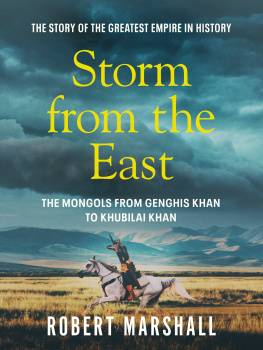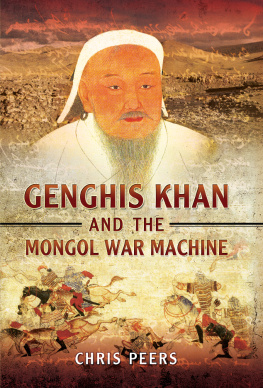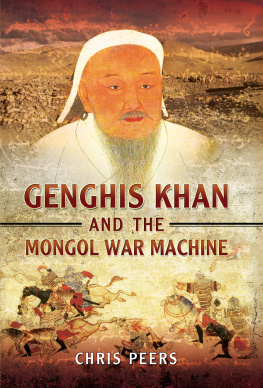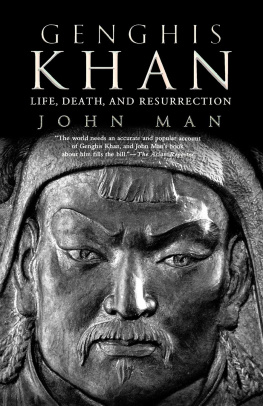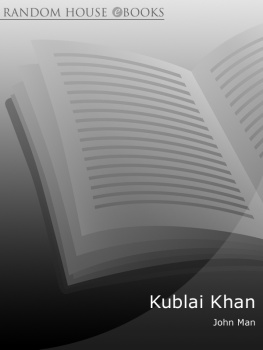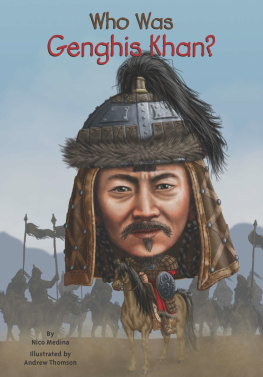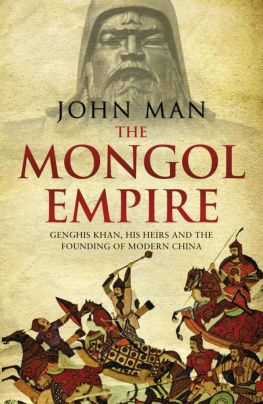Genghis
Khan
Series Editor C.S. Nicholls
Highly readable brief lives of those who have played a significant part in history, and whose contributions still influence contemporary culture.
Genghis
Khan
J AMES C HAMBERS

First published in 1999
This edition published in 2009
The History Press
The Mill, Brimscombe Port
Stroud, Gloucestershire, GL 5 2 QG
www.thehistorypress.co.uk
This ebook edition first published in 2012
All rights reserved
James Chambers 1999, 2009, 2012
The right of James Chambers to be identified as the Author of this work has been asserted in accordance with the Copyrights, Designs and Patents Act 1988.
This ebook is copyright material and must not be copied, reproduced, transferred, distributed, leased, licensed or publicly performed or used in any way except as specifically permitted in writing by the publishers, as allowed under the terms and conditions under which it was purchased or as strictly permitted by applicable copyright law. Any unauthorised distribution or use of this text may be a direct infringement of the authors and publishers rights, and those responsible may be liable in law accordingly.
EPUB ISBN 978 0 7524 8663 5
MOBI ISBN 978 0 7524 8662 8
Original typesetting by The History Press
C ONTENTS
A N OTE ON T RANSLITERATION
The vast Mongol Empire, which encompassed many different nations and cultures, presents historians with two so-far insuperable difficulties. First of all, the earliest records were written in such a broad diversity of languages that nobody has yet been able to read all of them in the original. Second, as Dr David Morgan wrote in the introduction to by far the best general work on the subject, there is no satisfactory solution to the problem of transliteration when one is dealing with words from so many languages and scripts.1
The consequence of the first difficulty is that some books on the Mongols are inevitably biased towards the authors speciality; and the consequence of the second is that they all contain a variety of justifiable spellings for the names of the same people and places. With some languages the differences are due simply to the development of new systems. Today, for example, most books use Beijing to represent the Chinese name for the city that other books called Peking. But at the other end of the scale there has never been a universally accepted system of transliteration into English from Mongolian. Even the specialists still differ in their spelling of Mongol names.
The best anyone can do is aim at consistency, and even then there are likely to be compromises. Although the founder of the Mongol Empire is most accurately represented as Chingiz Khn, I have used Genghis Khan because this is the spelling by which he is best known to English speakers. Similarly, like many recent authors, I have used Kh or K rather than Q throughout, partly because it represents famous names in the form by which they are best known. For example, Genghis Khans most famous grandson is better known as Khubilai rather than Qubilai, just as the holy book of Islam is still better known as the Koran rather than the Qurn. For the sake of simplicity, I have also omitted the symbols for umlauts and accents.
Despite the difficulties, however, the variations in books which do not use the same spellings as I have used are very seldom so great as to prevent readers from recognizing the names instantly when, as I hope they will, they go on to read more about the astonishing medieval empire of the Mongol horsemen.
James Chambers
London, 1999
A CKNOWLEDGEMENTS
I would like to thank Christine Nicholls, Jaqueline Mitchell and Helen Gray for their help and patience in the preparation of this text.
If the publisher and the author have unwittingly infringed copyright in any picture or photograph reproduced in this publication, we tender our sincere apologies and will be glad of the opportunity upon being satisfied as to the owners title, to pay an appropriate fee as if we had been able to obtain prior permission.
C HRONOLOGY
1167 (?) | Temuchin is born in Mongolia |
1176 | Temuchin is bethrothed to Borte |
1180 | Temuchin murders his half-brother, Bekhter |
1183 | Temuchin marries Borte and becomes adopted son of the King of the Keraits |
1184 | Borte is kidnapped and rescued |
1185 | Temuchin is elected Khan of the Borjigid |
1187 | Temuchin is defeated by Jamuka at the battle of Dalan Balzhut |
1197 | Temuchin restores Toghrul to Kerait throne. Toghrul is appointed Wang Khan by Chin Emperor |
1199 | Temuchins soldiers save Wang Khan from the Naimans |
1202 | Temuchin is forced to withdraw to the Baljuna swamp after the battle of Kalakalzhit |
1203 | Defeat of Wang Khan. Temuchin ascends Kerait throne |
1205 | Jamuka is executed |
1206 | Temuchin is enthroned as Genghis Khan |
1211 | Genghis Khan invades China |
1214 | First siege of Zhongdu (Beijing) |
1215 | Fall of Zhongdu |
1219 | Genghis Khan invades Khwarazm |
1220 | 19 March, Fall of Samarkand |
1226 | Genghis Khan attacks Tanguts |
1227 | August, Death of Genghis Khan |
O NE
T HE S ONS OF THE G REY W OLF
A cross the heart of the northern hemisphere, from Hungary to China, there are almost a hundred thousand square miles of desolate, treeless grassland known as the steppes. Throughout their long winter most of their earth is frozen solid. In the spring and the autumn their air is often thick with torrential rain. At the height of their short summer the yellow grass is baked brittle. For the most part they are good for very little other than hunting and herding hardy livestock; and they are so inhospitable that many of the people who first lived there moved on as soon as they could, migrating to conquer and settle in the richer soil of Europe, the Middle East or China.
At the eastern end of the steppes, however, the landscape is different. At first the grassland degenerates into a barren desert, the Gobi, but in the north, beyond the desert, there are rich rolling pastures rising amid many rivers to the forested foothills of Mount Kentey, a sacred mountain which was known long ago as Burkhan-Khaldun, Gods Hill. The people who live there today are the people who have always lived there and, like the haunted land itself, they are different.
According to their ancient legends, the nomads of the eastern steppes are unlike any other people on earth. At the dawn of time, they say, after the God of Eternal Heaven, Mongke Tengri, had made all the animals, he made the first human beings, moulding them out of clay. But the eastern nomads were not created until later, when the grey wolf, the great hunter, wandered down out of the forests on the side of the sacred mountain. Some say that he mated with a woman. Others say that he mated with a swift tawny doe. But all are agreed that the offspring of this union are the Mongols.



